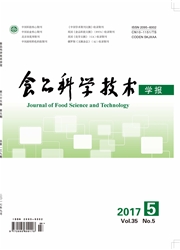

 中文摘要:
中文摘要:
探讨了超声波辅助前处理对花生分离蛋白复合酶解的影响,比较了碱性蛋白酶、木瓜蛋白酶、胰蛋白酶、胃蛋白酶、中性蛋白酶、风味蛋白酶等六种蛋白酶解物清除DPPH自由基的效果,确定碱性蛋白酶和胰蛋白酶较佳的复合比例为8∶2.在此基础上,开展响应面优化试验,以DPPH自由基清除率和水解度为指标,探讨复合酶与风味蛋白酶酶解的较佳工艺参数,并分析DPPH清除率和水解度相关性.实验结果表明,复合蛋白酶制备花生分离蛋白抗氧化肽的较佳酶解工艺为pH 8.5,温度49.36℃,酶添加量(E/S,质量分数m/m)3.40%,酶解时间203.59 min.
 英文摘要:
英文摘要:
Peanut protein prepared by ultrasound pretreatment was hydrolyzed with alkaline, papaya protease, trypsin, pepsin, neutral protease, and flavourzyme using DPPH free radicals scavenging activity as the indicator. The results showed that the optimal enzymes were alkaline and trypsin and the combined ratio was 8: 2. The optimal hydrolysis conditions of multi-enzyme and flavourzyme were investigated by means of response surface methodology (RSM). The correlation between degree of hydrolysis (DH) and DPPH free radical scavenging rate of hydrolyzed peanut protein isolate was further studied. The optimal hydrolysis condition for antioxidant peptides using multi-enzyme was pH 8.5, hydrolysis temperature 49.36 ℃ , the amount of enzyme 3.40% (m/m) , and hydrolysis time 203.59 min.
 同期刊论文项目
同期刊论文项目
 同项目期刊论文
同项目期刊论文
 期刊信息
期刊信息
